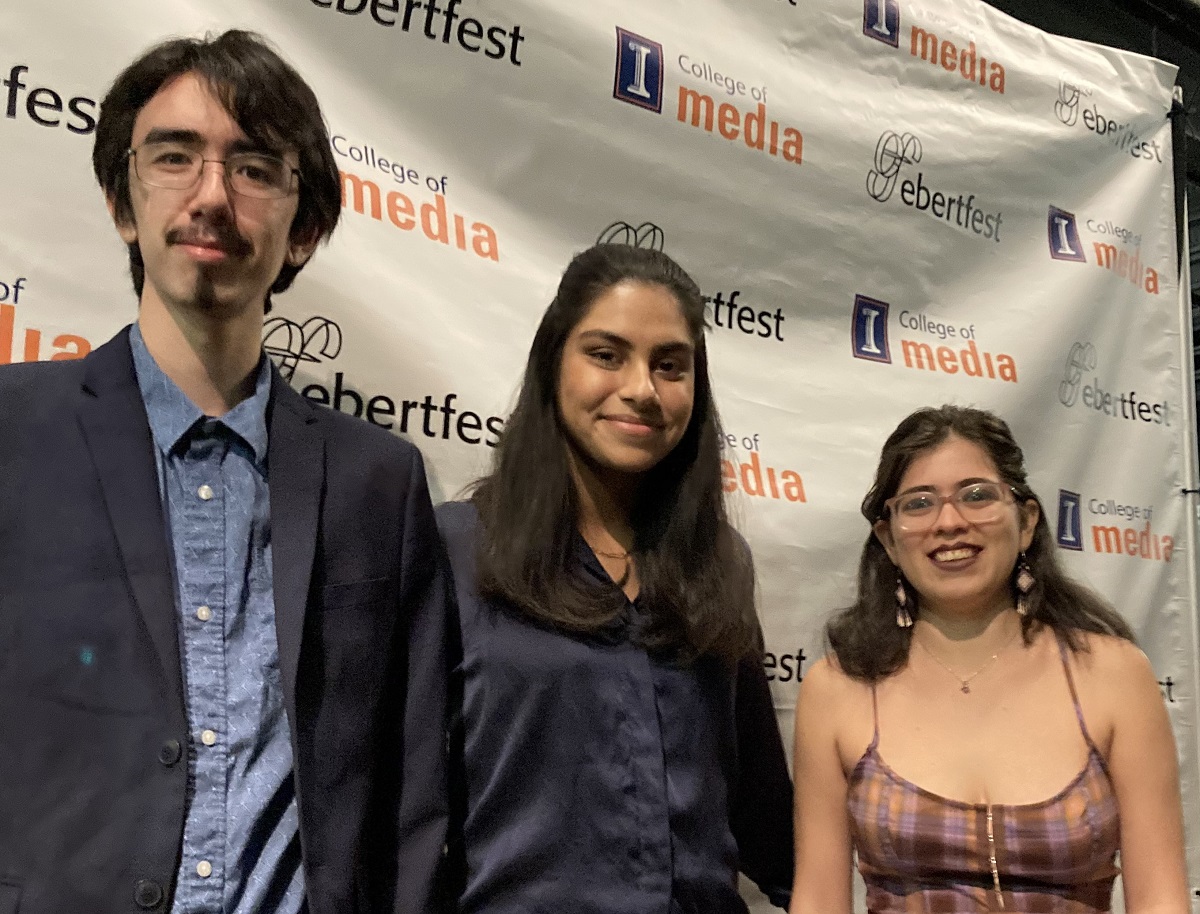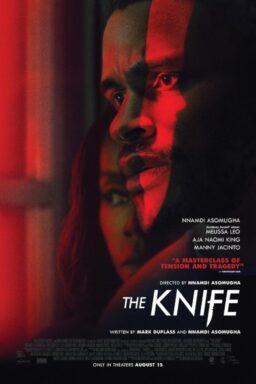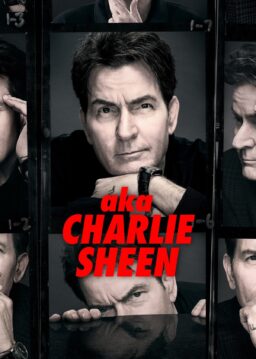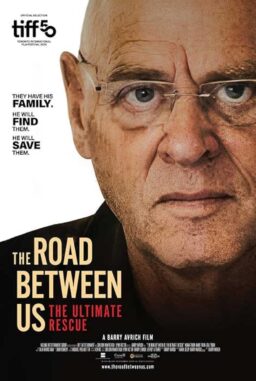We are pleased to present the following essays written by the 2022 Ebert Fellows about their experiences at this year’s Ebertfest. Thank you to Michael Phillips for leading this program under the auspices of the College of Media at the University of Illinois at Urbana-Champaign.—Chaz Ebert
Ebertfest 2022: A Time for Visceral Impact by Zeke Allis
With theaters reopening, and the theatergoing tradition becoming familiar again to many people, watching a movie with many other people in the room didn’t feel exactly alien. But the idea of an in-person film festival, showing a unique range of movies to a wide audience in its third year of pandemic life, felt novel all the same. The festival’s longtime venue, the large and fancy Virginia Theatre, made it feel special.
For me the two standout films were the 2015 drama “Krisha” and the 2021 melodrama “Nightmare Alley”—both pushing audiences into unfamiliar, even uncomfortable territory to allow them the catharsis of a harrowing, extraordinary experience.
Director Trey Edward Shults’ “Krisha” stars Krisha Fairchild, who attended Ebertfest and spoke in a post-screening discussion. The film feels like a punch in the gut, and that feeling was only heightened when shared by hundreds of people at the Virginia. It’s a slow burn that follows the title character as she tries to reconnect with her family during Thanksgiving.
Krisha has a complicated relationship with that family because of her addiction to alcohol. To say the atmosphere of the film is oppressive would be an understatement. The creepy music, the extremely realistic performances, the precise camerawork all work in unison to create tension. Many of the scenes would play completely differently without the horror-like score in the background. The acting, largely improvised between the cast members, many of whom are actual family, contrasts with the precise, deliberate movements of the camera. The acting makes us feel like this is real, but Shults’ camera doesn’t let us fall into that idea completely.
This gives the audience a very uneasy feeling, culminating in a nerve-wracking finale. When the credits rolled, the collective shock and awe of the audience could be felt, almost as if everyone simultaneously sighed after holding their breath.
My other favorite, “Nightmare Alley,” was directed and co-written by Guillermo del Toro and was a great film to share with others at a film festival. The version shown at Ebertfest was in black and white, as del Toro wanted it to be released. After looking at the color version, I can definitively say I prefer the black and white. It gives the entire film a darker tone, making menacing scenes even more menacing. It also calls back to the film noir style that inspired it. Seeing a film emulating an old style so successfully gave the audience a full experience, where you and others share a love of old and new cinema at the same time.
Based on the novel by William Lindsay Gresham, and the 1947 film version, “Nightmare Alley” feels like a novel–not only because of its length but also because of what it does with it. The protagonist Stan goes on a journey, and it is on full display. From his beginnings at the carnival to his power struggle with Lilith and his ultimate fate, there is very little of this man’s development we’re not shown. As Stan grows from a desperate man into a con-artist with little remorse, we know exactly how he becomes what he is. Everyone in the film has a unique story, but in the world of “Nightmare Alley,” no one is special. When Stan, played by Bradley Cooper, approaches his fate, the audience too realizes this terrible truth about the world. To be in a theater is to have a learning experience shared by many, and this Ebertfest screening served as a prime example.
“Krisha” and “Nightmare Alley” worked well at Ebertfest because they shocked the audience in visceral ways. Both were unafraid to explore dark themes, and the festival was unafraid to share these themes with a wide audience. As the world tries to pull itself into a better place, positivity will be a priority. But life will always be imperfect, and messages like the ones these films provide are necessary to come to grips with that fact. What better way to reach a moviegoing catharsis than to digest those themes along with a crowd of like-minded viewers?
Even if the collective emotion of the audience is not happiness or joy, having that experience with the people at Ebertfest reminded me of why I love cinema so much.
On Summer of Soul and Soy Cubana by Zulema Herrera
The Roger Ebert Film festival returned in person this year, the first time since its cancellation in 2020 following the emerging COVID-19 pandemic. The festival line-up included narrative features, non-fiction films and classics ranging chronologically from the Josephine Baker silent feature “The Siren of the Tropics” (1927) to titles released last year. The four-day Ebertfest commenced and concluded with two music documentaries: the Oscar-winning “Summer of Soul” (2021) and “Soy Cubana” (2016). After two years of audiences effectively deprived of an immersive moviegoing experience, the on-screen sounds and live musical performances filling the Virginia Theatre as part of Ebertfest made for a serious treat.
Festival co-founder and host Chaz Ebert kickstarted the 2022 Ebertfest with “Summer of Soul,” directed by Ahmir “Questlove” Thompson. The film showcases newly restored footage of concert performances from the 1969 Harlem Cultural Festival featuring artists such as Stevie Wonder, B.B King, Gladys Knight and Nina Simone, among many others.
Heavily overlooked next to the Woodstock festival happening that same summer 100 miles north, the Harlem festival made a huge impact on its outdoor audiences and then basically disappeared for nearly 50 years. The festival was a celebration of Black history, culture, music, and politics highlighting prominent figures in the civil rights movement. The neglect of this video footage, found stored away in a basement, reflects the particular mistreatment of Black people and their stories. Films like “Summer of Soul” push against this treatment, placing Black musical artists as fully worthy of being archived in our cultural memory.
One of the film’s modern-day interview subjects, festival attendee Musa Jackson, calls the Harlem festival the “ultimate Black barbecue,” attended by thousands of men and women embracing popular late ‘60s attire including dashikis and headwraps. People embraced their African identity as resistance to conformity, with a display of their Black pride.
“Summer of Soul” covers a mix of genres of blues, jazz, gospel, folk, Latin music or a combination thereof, with a rich variety of artists expressing a full diversity of influences within the Black community, especially in the Harlem area. But “back then, musical was segregated,” Billy Davis Jr., a member of the Fifth Dimension, says in the documentary. “Pop groups weren’t playing Black music, and Black groups weren’t playing pop music. And so we were caught in the middle.” Fellow Fifth Dimension legend Marilyn McCoo, recalling how it stung when she heard complaints in 1969 about the group’s so-called “white sound,” says simply: “How do you color a sound?”
“Summer of Soul” pushes musical boundaries with gospel singers like Pop Staples and the Staple Singers, or bands indebted to Afro-Latino presence/influences. The film leaves us with the question of why Black voices, particularly those featured in this concert footage, are so often silenced. The empty Harlem park becomes a metaphor for the forgotten festival. At the Ebertfest screening, Chicago jazz vocalist Tammy McCann performed along with the multi-genre Ther’Up band. Songwriter Clem Snide also took the stage, and all the live performances underlined the significance of coming together as a community.
Three days later, the music documentary “Soy Cubana,” which debuted as a short film in 2016, screened at the Virginia Theatre prior to “Nightmare Alley.” The filmmakers focus on the all-female group, featuring four Cuban women from Santiago de Cuba, as they attempt to perform their songs internationally. Co-director Jeremy Unger and producer Robin Miller Unger are the mother/son duo who met the Vocal Vidas quartet during a visit to Cuba.
The Ungers made a special guest appearance at Ebertfest to introduce the film, noting that the Virginia Theatre was the biggest house “Soy Cubana” had ever screened — which resulted in cheers from the audience.
“Hearing these voices in this stone chapel (in Santiago de Cuba), there were just a few of us there listening,” said Robin after the Ebertfest screening. “It was one of those moving experiences where you get the goosebumps and you just think this too good not to share with the world.”
“Soy Cubana” introduces the street life and culture of the city of Santiago de Cuba, along with the Vocal Vidas. They are Anita, the soprano named the “magical flute”; Annia, the contralto who brings the “sazon”; Koset, the mezzo-soprano who is the “rice”; and Maryoris, the contralto bass who is the “salt” of the dish. Tourists surround them as they perform their songs, incorporating African-American gospel music to Latin Jazz to classic Cuban favorites. These varied influences aid in their connection with audiences. Tourism is a major source of income for the group, which was invited to perform in Los Angeles for a crowd of 3,000.
The LA concert opportunity happens after then-President Donald Trump announced his intention to close tourism with Cuba, making this trip ever more vital for not only their music but their livelihoods. “Culture is communication,” one family member says in the documentary, critiquing the harm in closing doors between countries.
Amidst the international uncertainties and issues surrounding the Vocal Vidas, “Soy Cubana” emphasizes what can be achieved through art and art alone. “This is a movie about the connected power of music,” said Jeremy Unger at the Ebertfest screening. “And about finding human connection in unexpected places.”
Ramin Bahrani on Making “The White Tiger” by Michelle Husain
“The first half of the novel was kind of fun to read, and then it flips and gets darker like it does in the movie. How do you do that? How do you convey that tone in the film?’”
This was the question co-writer/director Ramin Bahrani asked himself while adapting Aravind Adiga’s 2008 book The White Tiger for Netflix. The film version screened at Ebertfest 2022. The Netflix adaptation follows Balram Halwai (played by Adarsh Gourav) and his journey from the small town of Laxmangarh to leaving his family to become chauffeur for a rich Delhi family living behind a facade of benevolence. Balram eventually becomes an entrepreneurial giant, the predatory white tiger of the title.
Most people wouldn’t consider it worth their time to make the trek out to the Virginia Theatre, when it takes all of 10 seconds to pull the film up at home. But at Ebertfest, the post-screening discussion with director Bahrani added a dimension to the film-watching experience with an inside look at the production process. I had the additional pleasure of interviewing Bahrani that same day, in the lobby of the nearby Hyatt.
As he sipped on steaming tea to wind down after an eventful day, Bahrani talked about making “The White Tiger,” and the questions he had to ask himself when directing, editing, and writing this project.
Most of his films, Bahrani told me, thrive off the locations where the scenes were filmed. “So much about film is how the camera relates to the actor and how the actor relates to the landscape. The casting of the landscape and locations are as important as casting the actors. Is the location overwhelming the actor? Is it more about the actor and less about the location?”
If so, Bahrani explained, “then you’re adjusting the shots accordingly.”
Chaotic, high-traffic urban scenarios can be found throughout Bahrani’s earlier New York-set film “Chop Shop,” as well as the culminating scenes in “The White Tiger.” Bahrani gets candid about how to display more intimate moments while “you’re filming in environments you don’t often have control over. When Balram starts shouting at a beggar woman– I have no control over those streets. I didn’t have any extras. Those are all real people. In some cases, it’s done with a hidden camera. In other cases, you’re shooting and the camera’s there, but you’ve gotten rid of the crew. You’re just hoping people don’t look into the camera! And if they do, you’re using it anyway.”
Bahrani, unlike most film directors, edits his own work. He edited “The White Tiger” with the help of Tim Streeto and told me how they were “just trading stuff back and forth and then meeting and talking and brainstorming and then coming up with a plan. I like editing a lot. It’s a chance to reinvent things, it’s a chance to make discoveries, it’s a chance to rewrite the movie again.”
Bahrani also talks about adapting the novel into what became an Academy Award-nominated script. “It resulted in a [film] style I haven’t done before, something sort of different from my other films although the themes are the same. And I think that came from the book, really.”
The writer-director deviated from the source material by changing the character of Pinky (played by Priyanka Chopra Jonas). He describes it as “a total rewrite–trying to go with certain clues in the book and trying to build on them. She can have a different relationship to Balram than maybe the other people can’t. She’s a contrast to the other characters, which differs to how she’s portrayed in the novel.”
“The White Tiger” immerses you in its environment by enriching the story in all narrative aspects, from building complex characters out of the source material, or expertly calculating shots that reflect the psychological repercussions of Balram transcending his socio-economic status. In our talk, Bahrani fervently explained his journey with “The White Tiger” as well as his older films. He also offered some personal advice on how to be a better filmmaker. He made our conversation easygoing and a brilliant learning experience.
It was delightful to talk with him.











